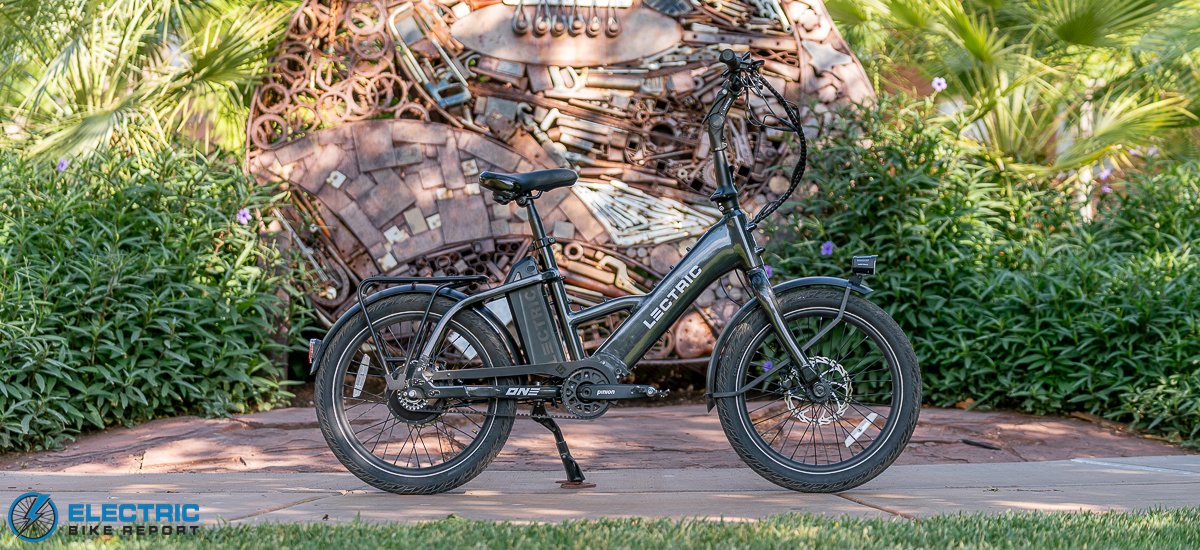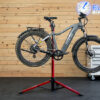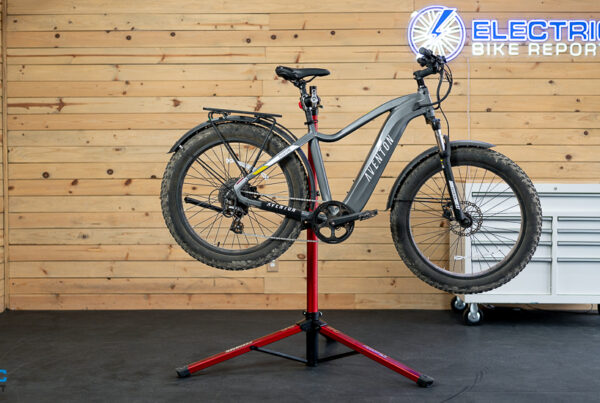So far, the Lectric ONE has shown solid performance in our testing, but ride quality—how a bike feels to ride—is where it truly shines. In this section, we will examine its fit, comfort, handling, operation and interface, motor engagement, and more.
Sizing and fit are two essential components of a comfortable ride. While the one may appear small (it sits low and has a relatively short wheelbase), its geometry is surprisingly accommodating; the bike fits riders from 5’2” to 6’4”.
At 5’11”, I was comfortably within its fit range, having full leg extension and a relatively upright riding position. The bike offers 8.5” of adjustment in saddle height (there was roughly 1” beyond my preferred position) and a quick-adjust stem. With this latter component, riders can adjust the reach and handlebar height to suit their needs.
While technically not a folding e-bike, the ONE has many features that make it much more portable than most full-size commuters. Its collapsible stem allows the handlebars to fold down, reducing the bike’s height. Its front wheel can easily be removed thanks to a quick-release thru-axle. The bike also has quick-release pedals to reduce its width.
I found the bike to be comfortable, thanks to its ergonomic rubber grips, adjustable riding position, and grippy pedals. While there is no suspension, the bike’s 20×2.5” street tires offer some much-appreciated cushioning and shock absorption.
The absence of a suspension also improves the ONE’s already excellent handling, lending it a reliable and certain feel when cornering. Thanks to the bike’s wheelbase and small wheels, it feels extremely agile and maneuverable, with a remarkably small turning radius and quick steering. It’s truly a blast to zip around on!
It is worth pointing out that I often found myself striking my heels on the bike’s chain stays, though I do have rather large feet. With US men’s size 12 shoes, I needed to scoot my feet forward on the pedals more than I usually prefer, though I adapted to the change rather quickly.
The bike’s Pinion gearbox and electronic shifting are two primary contributors to its excellent ride quality. In terms of feel and function, it would be difficult to find a more user-friendly system; the Pinion system allows for quick, snappy shifting even when pedaling uphill or at a standstill. It also feels and sounds well-made and high-tech.
Once paired with the Pinion Smart.Shift app, users can choose to activate one of two semi-automatic shifting modes. With Start.Select active, the gearbox will automatically downshift to a chosen gear after a short delay upon stopping. The Pre.Select function incorporates this feature but also downshifts when coasting to match a desired cadence.
Additionally, the pairing of this system with a Gates Carbon belt makes the experience of owning the bike extremely low-maintenance. The belt is rated to last twice as long as a chain while being smoother, quieter, and cleaner (no lubrication is needed). The Pinion system itself needs an oil change after every year or 6,200 miles, whichever comes first.
While the Pinion app is essential, the Gates Carbon Drive Belt Tension Tool app is another useful thing to download, as it allows owners to check the belt’s tension by strumming it like a guitar string.
I found the ONE’s cockpit and user interface to be straightforward and uncomplicated; the throttle lever and button panel sit on the left handlebar, while the shifters are on the right. I liked the central color LCD, though this was not without its quirks.
In previous sections, I mentioned that the bike could burn through battery charge relatively quickly when its acceleration force was set too high. The bike’s battery charge readout made predicting the remaining range difficult, as it fluctuated often based on how I was riding. We’d prefer a display with a percentage-based charge indicator for better reliability.
Otherwise, I thoroughly enjoyed the ONE’s lively and powerful motor, responsive feel, nimble handling, and super-cool tech. Minor hiccups aside, the ONE is a seriously unique bike with excellent ride quality!
.
.
.
#Lectric #Review #Electric #Bike #Report
Source link








